Top 10 Stitch Data Competitors & Alternatives 2026
Summarize this article with:
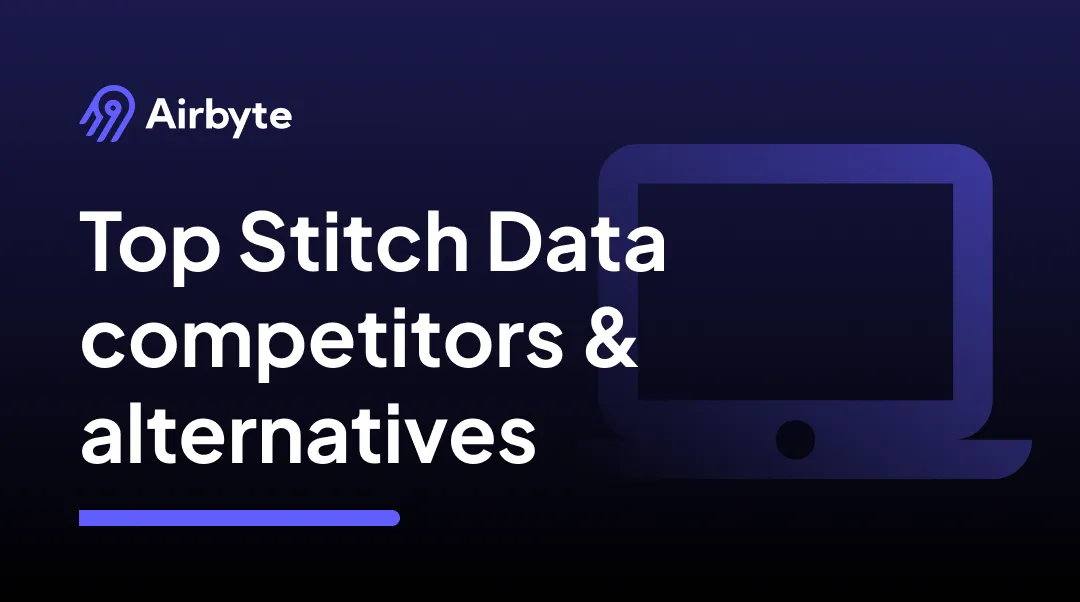

A large volume of data is generated daily on different applications. In order to analyze data and derive meaningful insights from them, you need to integrate data from these sources into a unified system. Stitch Data is a robust data integration platform that you can leverage to automate your data movement. It is a cloud-first platform that ensures fast and efficient data transfer from one place to another. However, with the growing business demands, a more powerful tool with advanced features is the need of the hour.
This article will give you an overview of the features of Stitch Data, along with suitable Stitch Data alternatives to cater to different integration needs.
Stitch Data Overview
Developed by Talend, Stitch Data is a powerful integration platform that helps you connect data from diverse databases, SaaS applications, and other systems into a unified destination. It offers a user-friendly UI, 140+ pre-built connectors that include popular data sources, and automated data pipelines. With Stitch, you can streamline your data integration processes and unlock valuable insights from different data sources.
Some of the key features of Stitch Data include:
- Stitch Data offers orchestration features that allow you to manage and control your data pipelines completely during the data transfer process.
- With Stitch Data, you can ensure data security and compliance as it offers access control and encryption features. Using options like SSL/TLS, SSH tunneling, and IP whitelisting, you can secure your data movement from different sources to a unified destination.
Why Are People Moving Away from Stitch?
- Pricing Structure: Stitch’s pricing model is relatively high when dealing with large amounts of data. Stitch employs the ‘row-based pricing model,’ where the costs can quickly rise with the increasing data volume.
- Connector limitations: Stitch supports a good amount of connectors but some users complain that it does not support new data sources. This can be a problem for organizations that have complex or changing data environments.
- Scalability Concerns: Stitch may not scale efficiently to handle growing volumes and the rising complexity of data.
- Rise of Open-source Alternatives: Open-source ETL tools like AirByte are gaining traction. These tools provide more control, flexibility, and possible cost savings for users compared to Stitch.
- Poor Customer Support: People who have used Stitch before reported that they aren't getting the technical support they need to use the platform to its full potential.
Top 10 Stitch Data Competitors
Let’s look at some popular Stitch Data alternatives you can utilize to fulfill your business requirements in 2026.
Airbyte
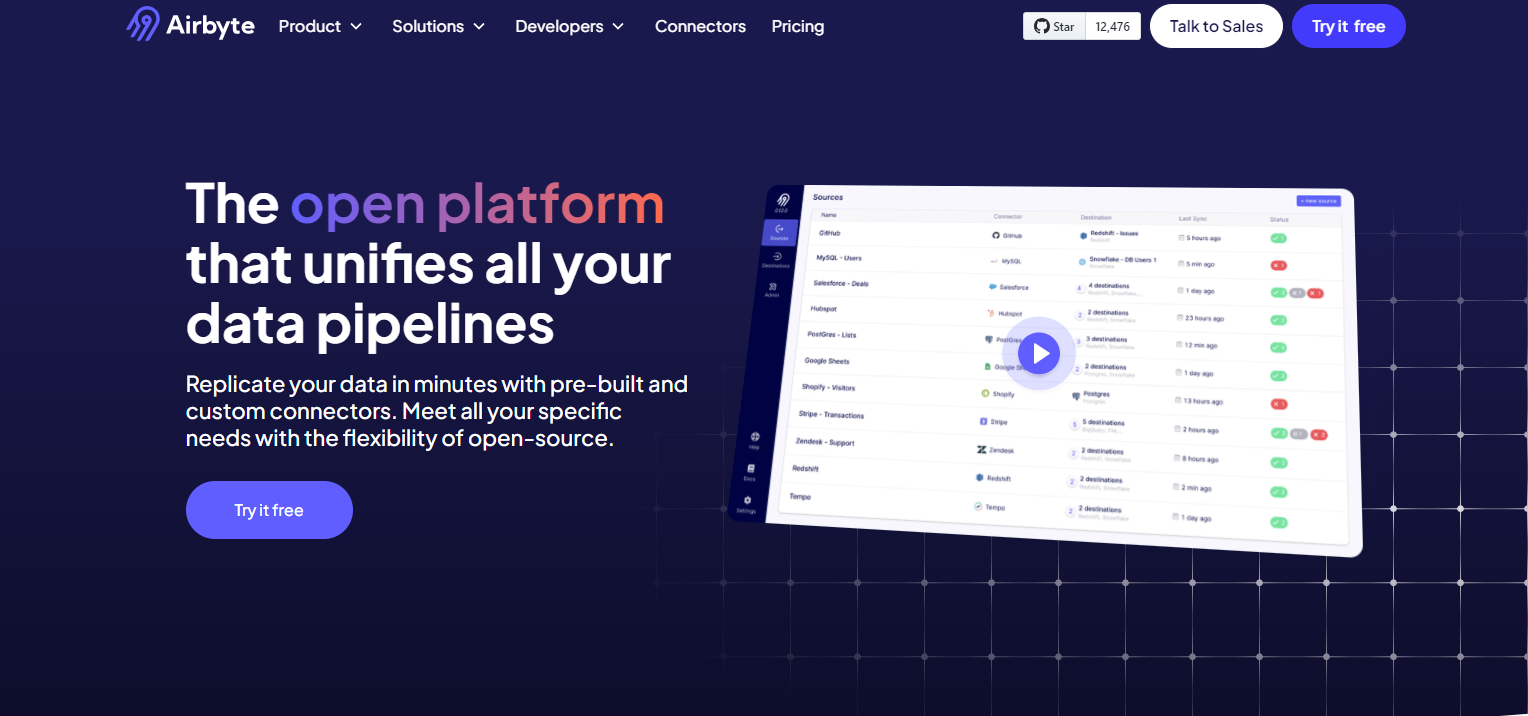
Airbyte is a widespread data integration tool that helps you synchronize data from disparate sources into a single destination. With over 600+ pre-built connectors, it offers one of the largest libraries of connectors, enabling you to create quick data pipelines. If the desired connector is unavailable, you can swiftly build custom connectors using the Connector Development Kit within minutes. In addition to data integration, it also allows you to set up and manage data movement operations, such as task scheduling and alerting.
Key features of Airbyte:
- AI-powered Assistant: In addition to CDK, Airbyte provides a Connector Builder option with an AI-powered assistant to automate the creation of custom connectors. The AI assistant captures and pre-fills the configuration fields with relevant details from the API documentation.
- Change Data Capture: Airbyte supports Change Data Capture (CDC), which lets you detect and capture the latest changes in source data and replicate them in the destination system.
- PyAirbyte: With Airbyte’s open-source Python library, PyAirbyte, you can extract data from sources using Airbyte supported connectors. You can then perform various transformations using Python libraries before moving your datasets to a destination of your choice.
- Robust Security: It adheres to strong security measures, such as audit logs, encryption, authentication mechanisms, and regular security assessments to ensure secure data transmission. The platform is compliant with several industry-specific regulations, such as HIPAA, SOC 2, GDPR, and ISO 27001.
- Record Change Feature: Airbyte provides a Record Change History feature that allows you to maintain a chronological record of all the changes made to your datasets.
- Team Collaboration: With Airbyte, you can collaborate with multiple users on a single instance. Additionally, you can utilize single sign-on or role-based access control for efficient user management, thus allowing you to handle your data pipeline effectively.
Pricing
Known for its transparent pricing, Airbyte offers three pricing plans—Cloud, Team, and Self-Managed Enterprise. In addition, it offers an open-source version that is free to use. For detailed information and pricing options, get in touch with Airbyte’s sales team.
Advantages of Airbyte Over Stitch Data
- Flexible Deployment Options: Airbyte enables you to build data pipelines in multiple ways, such as UI, API, PyAirbyte, and Terraform Provider. You can manage data pipelines without acquiring programming skills using the user interface. Advanced technical users can choose between PyAirbyte, API, and Terraform Provider.
- Integration with Data Stack: Airbyte is an efficient solution that allows you to integrate with a modern data stack, a feature notably absent in Stitch Data. You can seamlessly integrate with tools like Airflow, Kubernetes, Dagster, and dbt to facilitate quick data management.
- Supports Vector Databases: Airbyte provides connectors to popular vector databases, such as Pinecone, Milvus, and Weaviate, allowing you to store and process unstructured data with ease.
- LLM Integration: You can integrate Airbyte with LLM frameworks, such as LangChain, and perform RAG transformations to improve the performance of your LLM content.
- Schema Management: In Stitch, a schema specific to every integration is automatically created and stored in the destination. However, Airbyte provides you with advanced schema management. Once you configure the schema management settings, Airbyte checks for schema changes in the source data periodically.
- Vast Community: When it comes to community engagement, Airbyte is preferred over Stitch Data. Although Stitch Data uses the Singer platform to maintain community integrations, Airbyte has a vast AI and data community of 20,000+ users and 900+ contributors.
Skyvia

Skyvia is a cloud-based data integration platform using a no-code methodology to transfer data from source to destination. It allows you to perform several integration processes, such as ETL, ELT, and Reverse ETL. To seamlessly migrate data and automate workflows, it offers a collection of more than 160 connectors. If you cannot find the connector of your choice, you can always request a new data connector on its platform.
Key features of Skyvia:
- Skyvia offers a versatile approach to data transformation by providing both graphical components and SQL transformations that are simple to configure.
- You can leverage its strong backup and restore functionality to ensure data integrity and continuity. It allows you to perform manual and automatic daily backups so that your data is not lost while performing integration tasks.
- Skyvia offers robust data replication capabilities, allowing you to copy data between various sources such as databases, cloud applications, and files.
Pricing
Skyvia has four types of plans to tailor to your specific business requirements. The first plan is Free and can be used to integrate a small amount of data. The Basic plan can be utilized for performing ELT scenarios. If you want to leverage ETL and ELT approaches, you should use the Standard plan. The Professional plan is used to build powerful data pipelines for any scenario.
Suggested Read: Skyvia Alternatives
Fivetran
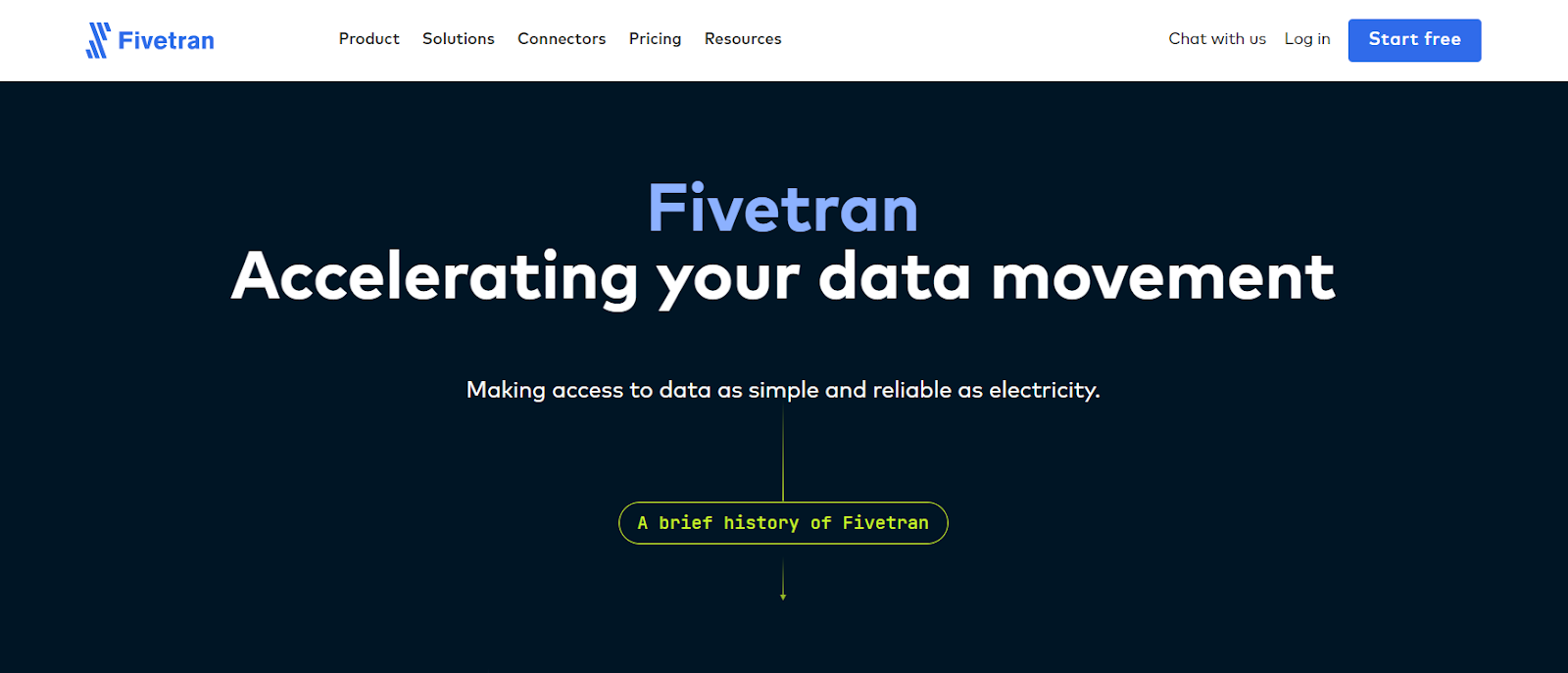
Fivetran is a cloud-based data movement platform that enables you to perform several integration tasks like ETL and ELT. It provides an automated data extraction and loading feature for complex data pipelines. You can use its library of 300+ connectors to sync data from APIs, databases, SaaS applications, and other sources into your desired destination, like data warehouses.
Key features of Fivetran:
- Fivetran enhances the data integration process by replicating schema changes from the source databases, ensuring your destination data remains up-to-date.
- It adheres to standard security practices by implementing column blocking and hashing mechanisms. While column blocking allows you to restrict specific columns from being replicated in your destination, hashing provides security for your Personally Identifiable Information (PII).
Pricing
Along with a free plan, Fivetran also comes with three paid versions—Starter, Standard, and Enterprise. You can choose a suitable plan tailored to your business needs. If you want to implement a modern ELT approach, opt for the Starter plan. However, if you require access to REST APIs, use the Fivetran Standard plan. The Enterprise plan provides advanced data security and governance features particularly suitable for scalable workflows.
Suggested Read: Fivetran Competitors
Integrate.io
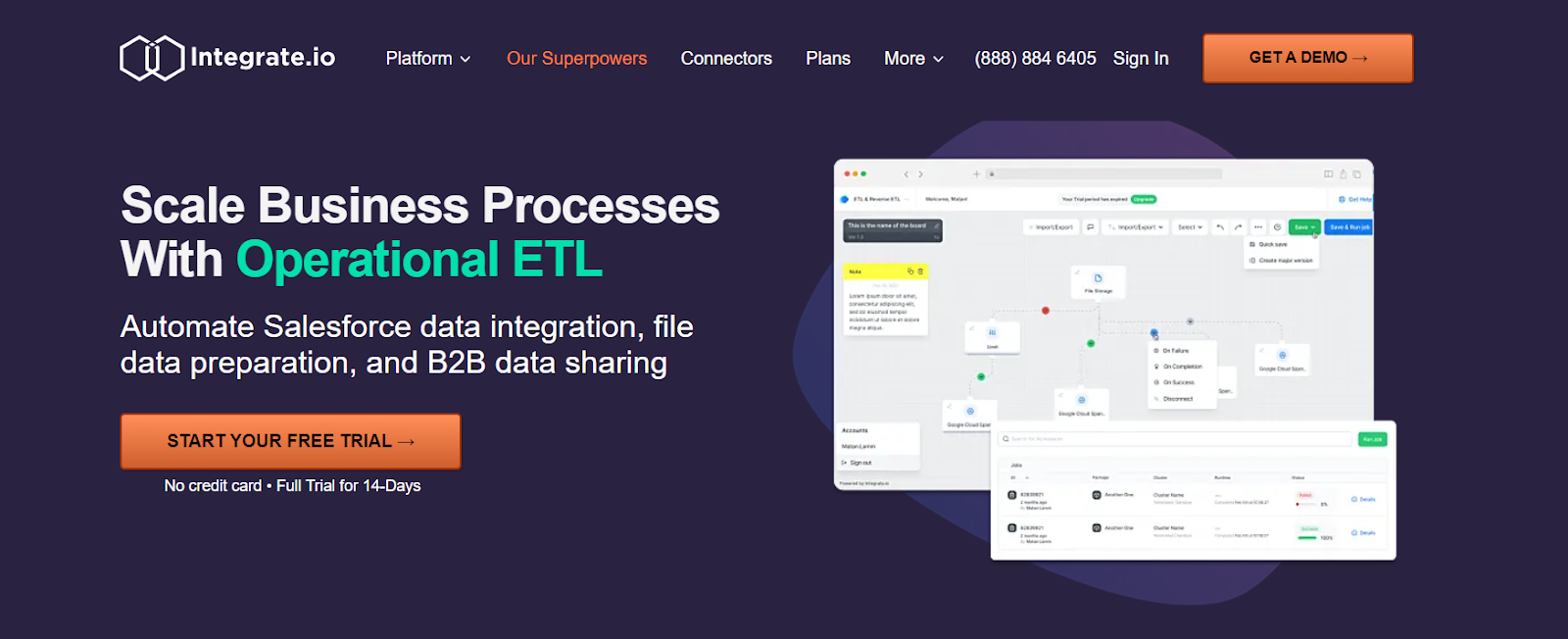
Launched in 2011, Integrate.io is a cloud-based data integration platform that supports ELT and low-code ETL processes. You can effortlessly design and execute data pipelines using its drag-and-drop interface. With integration capabilities, it also offers data replication features that allow you to capture changes from source files and replicate them into the destination files.
Key features of Integrate.io:
- Integrate.io hosts 100+ pre-built connectors for the most popular sources, such as Snowflake, Microsoft Azure, and Redshift.
- With Integrate.io, you can handle and transform in-pipeline data before it is loaded into the destination database. This helps in saving computer costs and enhancing quick processing when working with large datasets.
- You can access monitoring and logging information at your fingertips with Integrate.io. This feature enables you to prevent data errors and provides easy troubleshooting by tracking your data progress in real-time.
Pricing
Integrate.io offers a predictable and budget-friendly pricing plan to scale your data integration process. The Starter plan is available for free. The Professional version offers expanded features, such as supporting frequently running data pipelines. Lastly, an Enterprise plan provides comprehensive and customized solutions based on your business needs.
Hevo Data
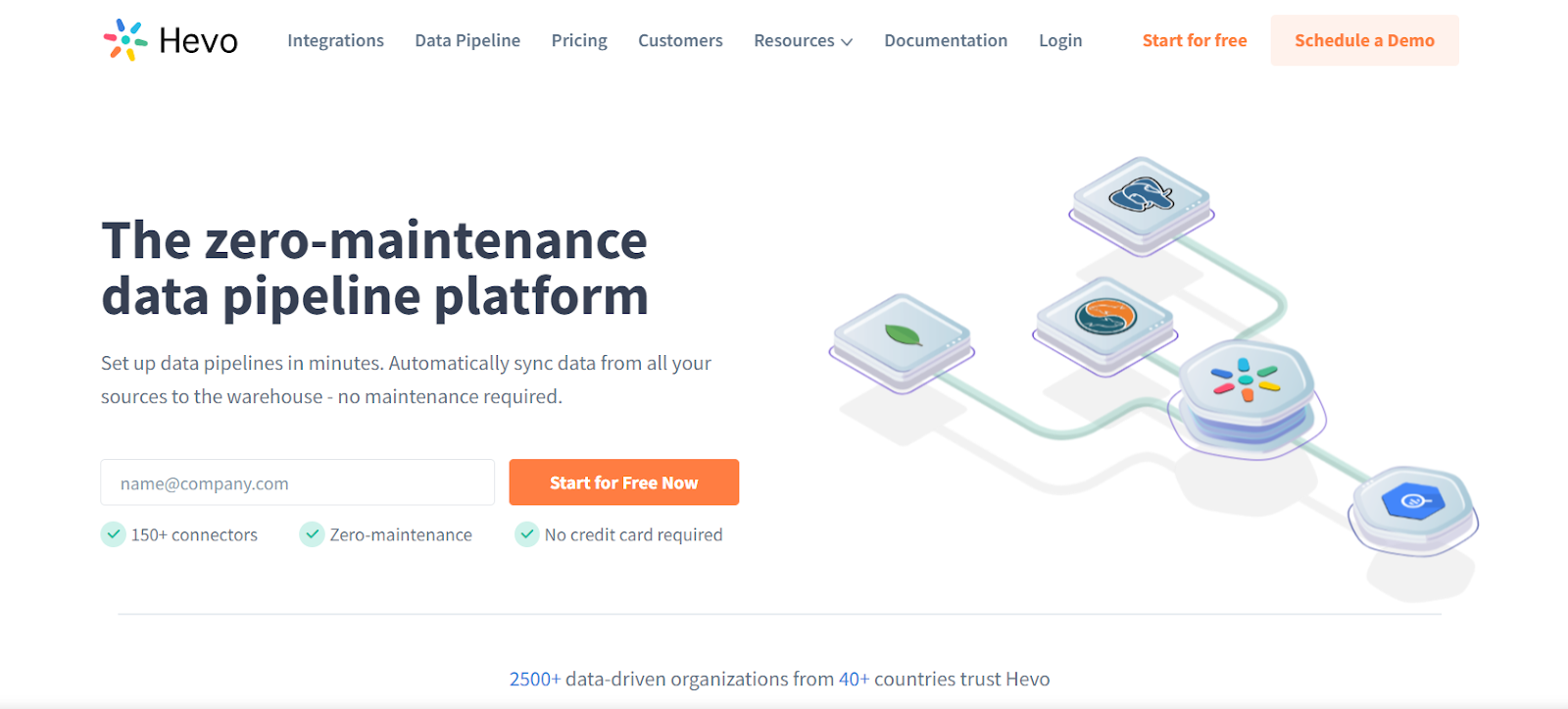
Developed in 2017, Hevo Data is a cloud-based data integration and replication platform that helps you manage data pipelines. It supports over 150 ready-to-use connectors, including SaaS applications, streaming services, databases, and SDKs. This helps you handle your data productively and perform data analytics.
Key features of Hevo Data include:
- Hevo Data facilitates automatic scalability by managing large volumes of data records effortlessly and adjusting as per workload requirements.
- You can use its no-code methodology to build your data pipelines without writing a single code.
- Hevo adheres to the most secure industry standards, such as GDPR, SOC 2, and HIPAA, to ensure data integrity and confidentiality.
Pricing
Hevo Data provides three pricing plans—Free, Starter, and Professional. The free version is available to all users and is effective for handling small volumes of data. The Starter plan has a library of 150 connectors, which allows you to transfer a limited amount of data from databases to a target system. However, if you want to migrate excessive data, the Professional version is suitable as it provides complete data control.
Suggested Read: Hevo Alternatives
Matillion

Matillion is a cloud-native data integration platform specializing in ETL for modern data teams. The intuitive, user-friendly visual interface makes the design and management of data transformation workflows very easy. Matillion also supports several integration capabilities with key cloud data warehouses like Snowflake, Amazon Redshift, Google BigQuery, and Microsoft Azure Synapse.
Key Features of Matillion:
- Cloud-Native Architecture: The Cloud-Native structure of Matillion gives it seamless integrations across different Cloud Warehouses, increasing performance and scalability.
- Full-featured ETL: Strong ETL with a large set of pre-built transformation components also allows writing custom SQL scripts.
- Scalability: Matillion can handle large volumes of data operations and easily find a place in large enterprises with sizeable data processing needs.
Pricing
Matillion packs a usage-based pricing model that grows with your growing volumes of data and processing. Different pricing tiers within the tool support varying business sizes and needs. It offers highly open pricing models, which can then be personalized to specific data integration workloads.
Suggested Read: Matillion Alternatives
Talend

Talend stands as a holistic data integration platform. Besides the commercial version, it also offers an open-source one, allowing the application to serve a diverse purpose in different businesses. The Talend platform opens the possibility to connect with as many varied data sources and destinations as the user wants, providing plenty of flexibility in data.
Key features of Talend:
- Open-source Flexibility: For businesses, it is an entry-level, cost-effective, and easy-to-learn data integration solution. The commercial software versions provide advanced features and customer support services.
- Data Quality and Governance: Talend incorporates features for data quality and data governance.
- Rich Connectivity: It can handle a huge number of data sources. Some of these include databases, SaaS applications, cloud storage, and many others for exhaustive data integration.
Pricing
Talend pricing—from its open-source for free to its support for enterprise/advanced features and dedicated support: The commercial plans are designed for different levels of data integration complexity and business requirements; therefore, one can choose a favorable plan that suits them from a variety of plans that Talend offers.
Suggest Read: Talend Alternatives
Informatica PowerCenter

One of the most widely used alternatives to Stitch, Informatica PowerCenter is an end-to-end data integration platform. It caters to data extraction, transformation, and loading from a diversity of data sources. It is also assists enterprises that require complex data workflows coupled with high performance and reliability.
Key Features of Informatica PowerCenter:
- Versatile Data Integration: PowerCenter supports a wide range of data integration tasks—ranging from batch and real-time processing to data quality management—that cut across seamless integration in both on-premises and cloud environments.
- Advanced Data Transformation: The platform provides high-end transformation features, thereby giving users the possibility of carrying out complicated data manipulations. These might range from data cleansing, aggregation, and normalization to ensure consistency in data and its accuracy.
- Strong Security and Compliance: Informatica PowerCenter adheres to the strictest security standards with features such as data masking, encryption, and role-based access control, among others. These features allow organizations to comply with any regulatory provision.
Pricing
Informatica PowerCenter has agile pricing. Its pricing is based on organizational needs and size. PowerCenter has customized quotes for different business strategies; hence, it offers only what is needed in terms of features and required organizational capacity.
Suggested Read: Informatica Alternatives
AWS Glue
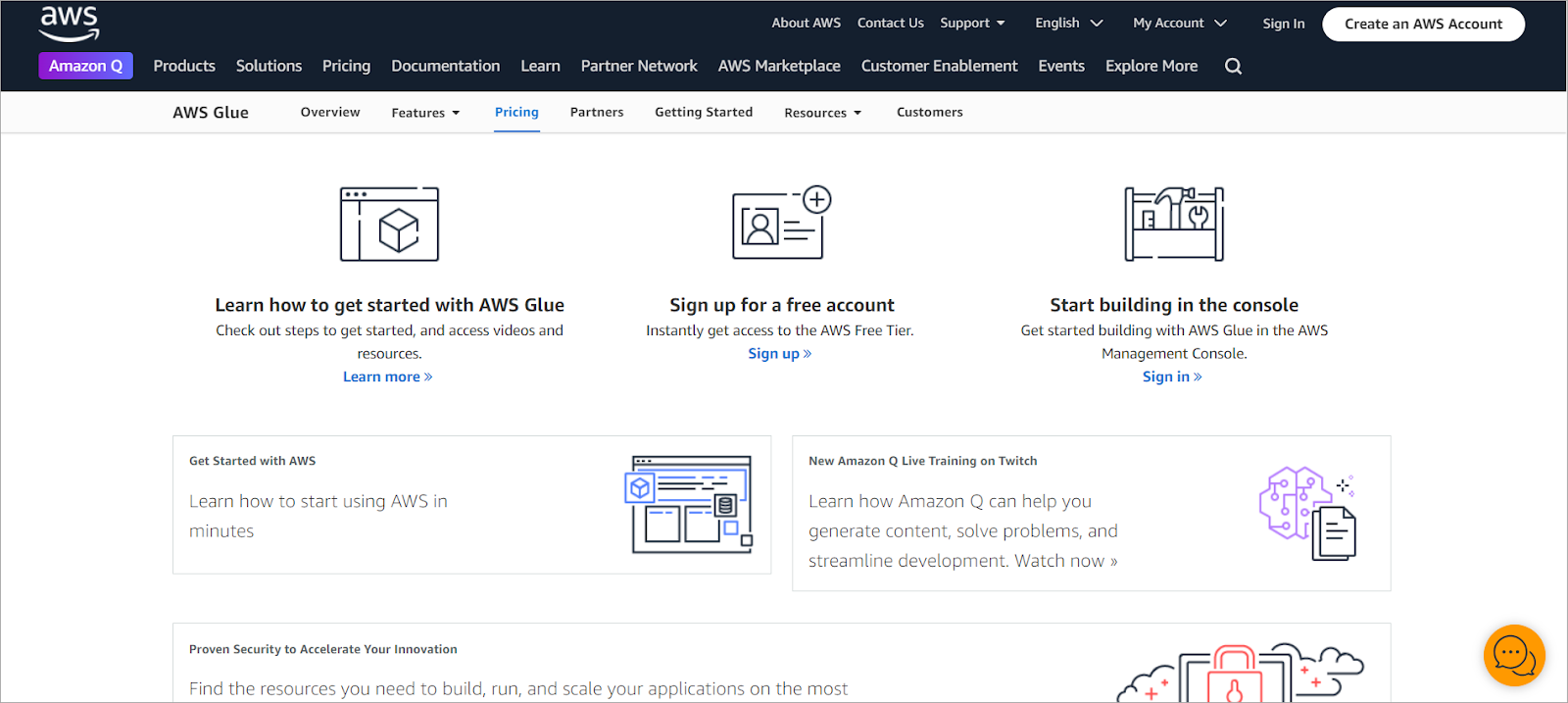
It is an AWS-managed ETL service that allows users to easily prepare and load data for analytics. It is an unassuming interface with incredibly strong capabilities in the space of data integration. AWS Glue can handle unstructured and structured data, which makes it versatile and useful for modern data environments.
Key Features of AWS Glue:
- Serverless Architecture: AWS Glue works on a serverless architecture, and thus there is no need for any kind of infrastructure management. This allows users to focus on their data processing tasks and not the hardware.
- Automated Schema Discovery: AWS Glue automatically discovers and catalogs metadata from various data sources; this makes searching for and querying data quite easy using the AWS Glue Data Catalog.
- Flexibility: It integrates very well with the other services from AWS, which supports running comprehensive data workflows.
Pricing
AWS Glue bases its pricing on a pay-as-you-go model for its users according to the data that is processed and the duration of its ETL jobs. This flexible pricing structure will ensure you pay only for the resources you are using. This makes it very cost-effective for businesses of all sizes.
Suggested Read: AWS Glue Vs. Airflow Vs. Airbyte
Dataddo
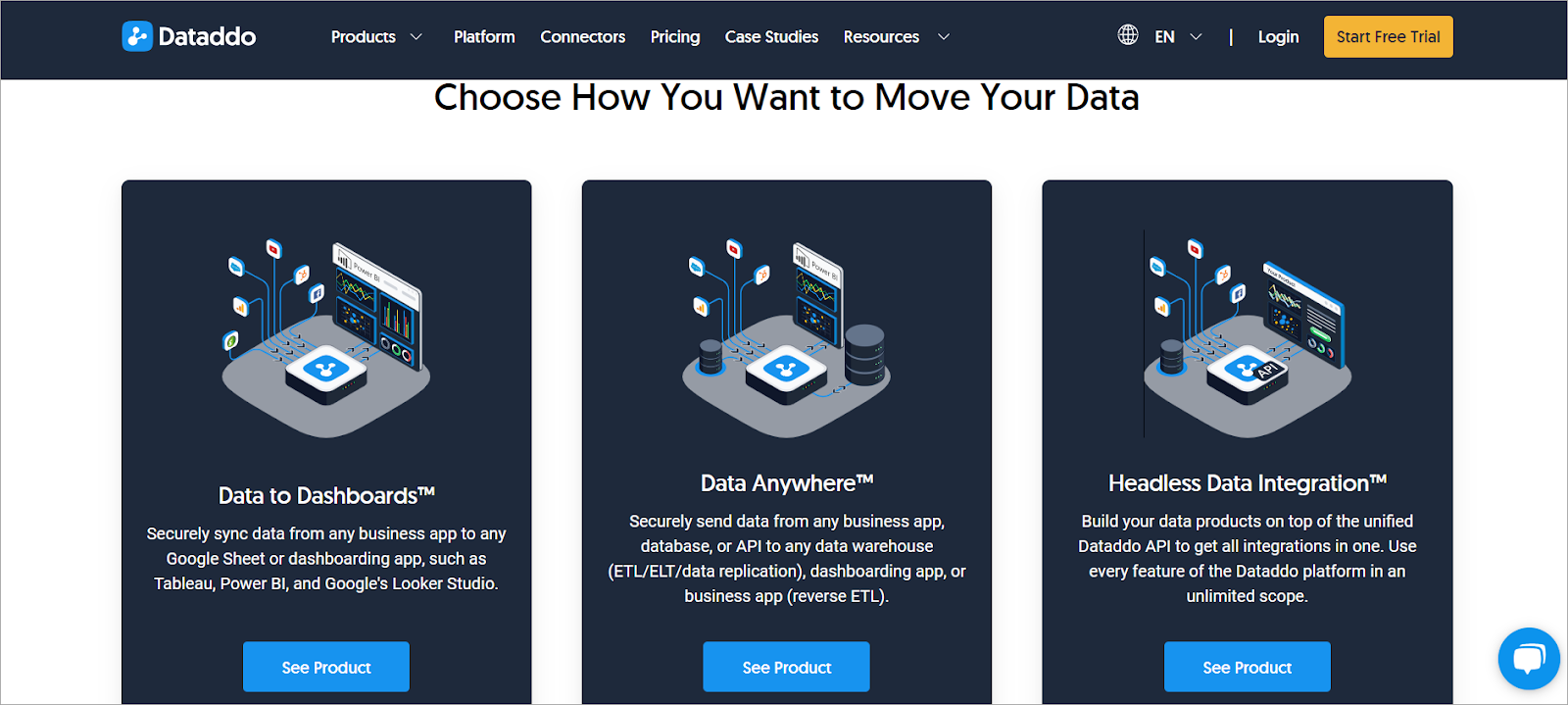
Dataddo is a data integration platform designed to easily connect, transform, and automate workflows. It supports a wide variety of data sources and destinations, providing an easy way to create quite complex data pipelines. Dataddo is fit for every organization looking for a user-friendly solution with robust capabilities in this regard.
Key Features of Dataddo:
- Large Connector Library: Dataddo offers a rich, off-the-shelf library of out-of-the-box connectors to connect data from a variety of APIs, databases, and SaaS applications. This flexibility can be instrumental in helping you hook up to almost any kind of data source.
- No-Code Data Integration: The platform is no-code, so it is friendlier for business users who have no IT background. One can rapidly design and manage data pipelines using a graphical design of workflows.
- Real-Time Data Synchronization: Dataddo allows the synchronization of data in real-time. This can be very important for companies that need fresh data for further actions.
Pricing
The pricing at Dataddo also varies by different business requirements. It contains a free plan, including the basic features, accompanied by a couple of paid plans targeting larger volumes and more advanced capabilities. This tiered pricing model ensures you pay for the exact plan you need to work within your budget and according to your requirements.
Final Word
Performing the right data integration process to unify your data is crucial as it saves time, money, and resources. Stitch Data is a popular platform that fulfills your integration needs by collecting all the data in one place. However, with changing business dynamics, you should also be ready to explore Stitch alternatives that provide advanced integration features.
We recommend leve
What should you do next?
Hope you enjoyed the reading. Here are the 3 ways we can help you in your data journey:



Frequently Asked Questions
What is ETL?
ETL, an acronym for Extract, Transform, Load, is a vital data integration process. It involves extracting data from diverse sources, transforming it into a usable format, and loading it into a database, data warehouse or data lake. This process enables meaningful data analysis, enhancing business intelligence.
This can be done by building a data pipeline manually, usually a Python script (you can leverage a tool as Apache Airflow for this). This process can take more than a full week of development. Or it can be done in minutes on Airbyte in three easy steps: set it up as a source, choose a destination among 50 available off the shelf, and define which data you want to transfer and how frequently.
The most prominent ETL tools to extract data include: Airbyte, Fivetran, StitchData, Matillion, and Talend Data Integration. These ETL and ELT tools help in extracting data from various sources (APIs, databases, and more), transforming it efficiently, and loading it into a database, data warehouse or data lake, enhancing data management capabilities.
What is ELT?
ELT, standing for Extract, Load, Transform, is a modern take on the traditional ETL data integration process. In ELT, data is first extracted from various sources, loaded directly into a data warehouse, and then transformed. This approach enhances data processing speed, analytical flexibility and autonomy.
Difference between ETL and ELT?
ETL and ELT are critical data integration strategies with key differences. ETL (Extract, Transform, Load) transforms data before loading, ideal for structured data. In contrast, ELT (Extract, Load, Transform) loads data before transformation, perfect for processing large, diverse data sets in modern data warehouses. ELT is becoming the new standard as it offers a lot more flexibility and autonomy to data analysts.
